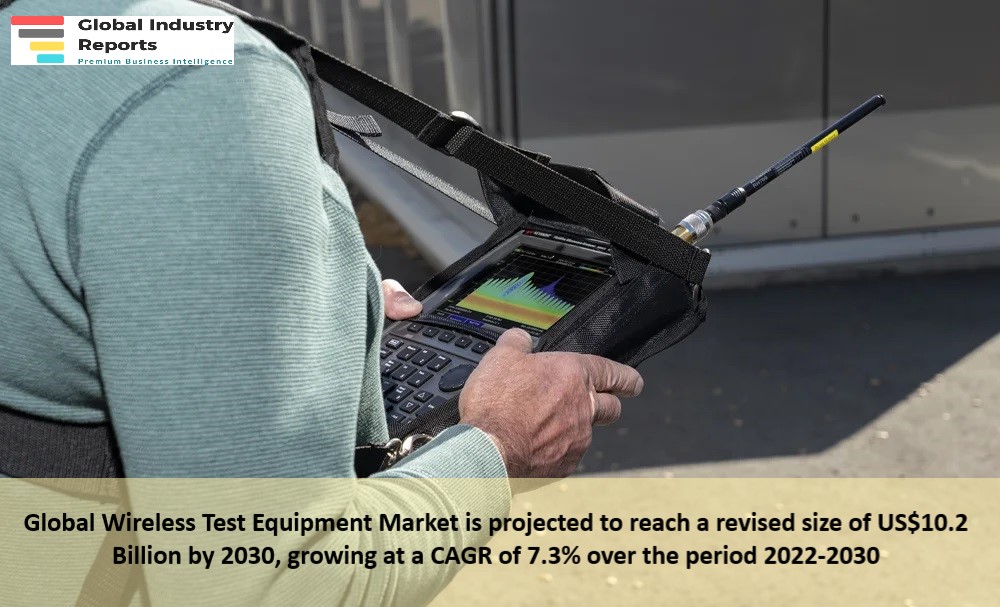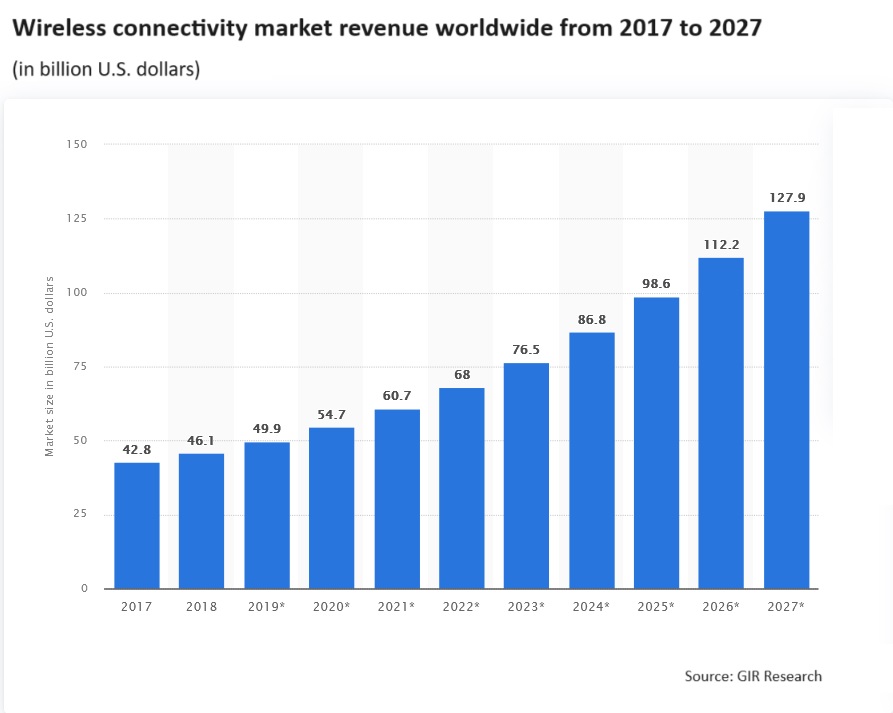Report Overview
- Understand the latest market trends and future growth opportunities for the Wireless Test Equipment industry globally with research from the Global Industry Reports team of in-country analysts – experts by industry and geographic specialization.
- Key trends are clearly and succinctly summarized alongside the most current research data available. Understand and assess competitive threats and plan corporate strategy with our qualitative analysis, insight, and confident growth projections.
- The report will cover the overall analysis and insights in relation to the size and growth rate of the “Wireless Test Equipment Market” by various segments at a global and regional level for the 2010-2030 period, with 2010-2021 as historical data, 2022 as a base year, 2023 as an estimated year and 2023-2030 as forecast period.
Description:
- The global market for Wireless Test Equipment estimated at US$5.8 Billion in the year 2022, is projected to reach a revised size of US$10.2 Billion by 2030, growing at a CAGR of 7.3% over the period 2022-2030.
- Wireless Infrastructure Test Equipment, one of the segments analyzed in the report, is projected to record 8.8% CAGR and reach US$6.3 Billion by the end of the analysis period. Growth in the Wireless Devices Test Equipment segment is estimated at 5.1% CAGR for the next 8-year period.
- The Wireless Test Equipment market in the U.S. is estimated at US$1.6 Billion in the year 2022. China, the world`s second largest economy, is forecast to reach a projected market size of US$2.2 Billion by the year 2030 trailing a CAGR of 9.4% over the analysis period 2022 to 2030. Among the other noteworthy geographic markets are Japan and Canada, each forecast to grow at 5.3% and 6.6% respectively over the 2022-2030 period. Within Europe, Germany is forecast to grow at approximately 6.1% CAGR.

MARKET DATA INCLUDED
- Unit Sales, Average Selling Prices, Market Size & Growth Trends
- COVID-19 Impact and Global Slowdown Analysis
- Analysis of US inflation reduction act 2022
- Global competitiveness and key competitor percentage market shares
- Market presence across multiple geographies – Strong/Active/Niche/Trivial
- Online interactive peer-to-peer collaborative bespoke updates
- Market Drivers & Limiters
- Market Forecasts Until 2030, and Historical Data up to 2015
- Recent Mergers & Acquisitions
- Company Profiles and Product Portfolios
- Leading Competitors
The Global Wireless Test Equipment Market Report Includes:
- In-depth exploration of the industry, encompassing definitions, classifications, and the industry’s interconnected structure.
- Examination of pivotal supply-side and demand trends.
- Detailed breakdown of both international and local products.
- Insight into historical volume and value dimensions, along with market shares of companies and brands.
- Five-year predictions regarding market trends and growth.
- A robust and transparent research methodology conducted within the country.
- A blend of qualitative and quantitative analysis, grounded in segmentation that considers economic and non-economic aspects.
- Provision of market value data (in USD Billion) for every segment and sub-segment.
- Geographical, regional, national, and state-wise analysis.
- A succinct overview of the commercial potential inherent in products, technologies, and applications.
- Company profiles of key market players operating within the product category.
- Descriptions of attributes and manufacturing processes.
- Segmentation based on type, application, end-users, regions, and other factors.
- Discussion about the current state, challenges, innovations, and future requirements of the market.
- Examination of the market based on application and product sizes: utility-scale, medium scale, and small-scale.
- Country-specific insights and analyses for major countries and regions.
- Coverage of historical context, pivotal industrial developments, and regulatory frameworks.
- Analysis of competitive movements, including agreements, expansions, new products, and mergers & acquisitions.
- Exploration of opportunities for stakeholders and a depiction of the competitive landscape among market leaders.
- Specialized coverage of significant global events, such as the Russia-Ukraine war, global inflation, China’s “zero-Covid” policy shift, supply chain disruptions, trade tensions, and the risk of recession.
- Evaluation of global competitiveness and market shares among key competitors.
- Presence assessment across various geographical markets: Strong, Active, Niche, Trivial.
- Online, interactive, peer-to-peer collaborative updates.
- Access to digital archives and the Market Research Platform.
- Complimentary updates for a two-year period.
Wireless Test Equipment Report Scope and Segments:
| Report Attribute | Details |
| Market size value in 2022 | USD 5.8 Billion |
| Revenue forecast in 2030 | USD 10.2 Billion |
| Growth Rate | CAGR of 7.3% from 2022 to 2030 |
| Base year for estimation | 2022 |
| Historical data | 2015 – 2022 |
| Forecast period | 2023 – 2030 |
| Quantitative units | Revenue in USD million and CAGR from 2023 to 2030 |
| Report coverage | Revenue forecast, company ranking, competitive landscape, growth factors, trends, DROT Analysis, Market Dynamics and Challenges, and Strategic Growth Initiatives
COVID-19 Impact, Market Growth Trends, Market Limiters, Competitive Analysis & SWOT for Top Competitors, Mergers & Acquisitions, Company Profiles, Product Portfolios Market Size, Market Shares, Market Forecasts, Market Growth Rates, Units Sold, and Average Selling Prices. |
| Segments covered | Product, Type, Technology, Application & Region |
| Regional scope | North America; Europe; Asia Pacific; Latin America; Middle East and Africa and rest of the world |
| Country scope | United States, China, Japan, Germany, India, United Kingdom, France, Brazil, Italy, Canada, South Korea, Australia, Russia, Spain, Mexico, Indonesia, Netherlands, Switzerland, Saudi Arabia, Turkey, Taiwan, Poland, Sweden, Belgium, Thailand, Austria, Nigeria, Argentina, United Arab Emirates, Iran, Norway, Israel, Ireland, Malaysia, Denmark, Singapore, Philippines, Pakistan, Finland, Chile, Vietnam, Greece, Czech Republic, Romania, Portugal, Peru, New Zealand, Hungary, Iraq, Bangladesh, Qatar, Kuwait, Ukraine, Egypt, Kazakhstan, Colombia, Angola, Algeria, Morocco, Slovakia, Oman, Puerto Rico, Ethiopia, Sudan, Kenya, Ghana, Dominican Republic, Myanmar, Tanzania, Ecuador, Belarus, Guatemala, Lithuania, Latvia, Sri Lanka, Nepal, Lebanon, Slovenia, Bahrain, Libya and others |
| Key companies profiled | 7 Layers GmbH; Accuver; ADLINK Technology, Inc.; Advantest Corporation; AEA Technology, Inc.; Agilent Technologies, Inc.; Ametek Inc; Anritsu Corp.; AT4 Wireless; AWT Global, LLC; B&K Precision; Beijing StarPoint Technology; Berkeley Varitronics Systems, Inc.; Bird Technologies Group, Inc.; Black Box Corporation; Bureau Veritas; CETECOM GmbH; Ceyear; Chroma Ate Inc.; Cobham Wireless (Formerly Aeroflex); Datrend Systems Inc.; DEKRA SE; Dingli Corporation; Elektrobit (EB); EMITE Ingenieria SL; Empirix; EXFO Inc.; Gemalto; Giga-tronics; Greenlee (Textron); GW Instek; Hermon Laboratories TI Ltd.; Infovista; Intertek; Keysight Technologies Inc.; LitePoint (Teradyne); Maury Microwave; MVG (Microwave Vision Group); National Instruments; NetScout Systems; R&S (Radiocommunications Testing); RADCOM; RIGOL Technologies; Rohde & Schwarz GMBH & Co. KG; Scientech Technologies Pvt Ltd; SGS Group; SIGLENT; Sivers IMA Holding AB; Spirent Communications Plc; TEKTRONIX; Teledyne; Teoco; Terabeam; Teradyne, Inc.; TESCOM; ThinkRF Corp; Transcom Instrument; Uni-Trend Technology; Viavi Solutions Inc.; Wi-Fi Alliance; Xcerra Corporation; Yokogawa Electric Corporation; ZTE Corporation and Others |
| Customization scope | Free report customization (equivalent up to 20 analyst’s working days) with purchase. Addition or alteration to country, regional & segment scope. |
| Report Format | PDF, PPT, Excel & Online User Account |

Wireless Test Equipment Market Report Segmented By:
Wireless Test Equipment Market By Offering:
- Equipment
- Services
Wireless Test Equipment Market By Connectivity Technology:
- Wireless network testing
- Wireless device testing
Wireless Test Equipment Market By Application:
- Consumer Electronics
- Automotive
- IT & Telecommunication
- Energy & power
- Medical devices
- Aerospace & Defense
- Industrial
- Others
Wireless Test Equipment Market By Region:
- North America
- Europe
- Asia Pacific
- South America
- Middle East & Africs
- Rest of the World
Companies covered in Wireless Test Equipment market Report:
| 7 Layers GmbH | Infovista |
| Accuver | Intertek |
| ADLINK Technology, Inc. | Keysight Technologies Inc. |
| Advantest Corporation | LitePoint (Teradyne) |
| AEA Technology, Inc. | Maury Microwave |
| Agilent Technologies, Inc. | MVG (Microwave Vision Group) |
| Ametek Inc | National Instruments |
| Anritsu Corp. | NetScout Systems |
| AT4 Wireless | R&S (Radiocommunications Testing) |
| AWT Global, LLC | RADCOM |
| B&K Precision | RIGOL Technologies |
| Beijing StarPoint Technology | Rohde & Schwarz GMBH & Co. KG |
| Berkeley Varitronics Systems, Inc. | Scientech Technologies Pvt Ltd |
| Bird Technologies Group, Inc. | SGS Group |
| Black Box Corporation | SIGLENT |
| Bureau Veritas | Sivers IMA Holding AB |
| CETECOM GmbH | Spirent Communications Plc |
| Ceyear | TEKTRONIX |
| Chroma Ate Inc. | Teledyne |
| Cobham Wireless (Formerly Aeroflex) | Teoco |
| Datrend Systems Inc. | Terabeam |
| DEKRA SE | Teradyne, Inc. |
| Dingli Corporation | TESCOM |
| Elektrobit (EB) | ThinkRF Corp |
| EMITE Ingenieria SL | Transcom Instrument |
| Empirix | Uni-Trend Technology |
| EXFO Inc. | Viavi Solutions Inc. |
| Gemalto | Wi-Fi Alliance |
| Giga-tronics | Xcerra Corporation |
| Greenlee (Textron) | Yokogawa Electric Corporation |
| GW Instek | ZTE Corporation |
| Hermon Laboratories TI Ltd. | Others |
After Sales Support
- Every updated edition of the report and full data stack will be provided at no extra cost for 24 months.
- Latest 2022 base year report.
- Free Updated edition of 2023 every quarter without any hidden cost.
- No user limitation for the report. Unlimited access within the organization.
- Unrestricted post-sales support at no additional cost
- Free report customization (equivalent up to 10 analyst’s working days) with purchase. Addition or alteration to country, regional & segment scope
- Global Industry Reports will support your post-purchase for a period of 24 months to answer any of your queries related to the following market and to provide you any more data needed, for your analysis.
- Option to purchase regional or some selected Chapters from the report.
Key questions that are answered in Wireless Test Equipment report
- What Is Wireless Test Equipment, and How Is It Used in the Industry?
- What Are the Key Factors Driving the Growth of the Global Wireless Test Equipment Market?
- What Types of Wireless Technologies Does Wireless Test Equipment Cover?
- How Is 5G Impacting the Demand for Wireless Test Equipment?
- What Role Does Wireless Test Equipment Play in Ensuring Network Security?
- What Are the Primary Applications of Wireless Test Equipment in Telecommunications?
- How Do Regulatory Standards Influence the Wireless Test Equipment Market?
- What Are the Key Challenges Faced by Manufacturers of Wireless Test Equipment?
- What Are the Latest Technological Advancements in Wireless Test Equipment?
- How Does the Evolution of IoT Affect the Need for Wireless Test Equipment?
- What Is the Role of Wireless Test Equipment in Ensuring Quality of Service (QoS)?
- How Do You Choose the Right Wireless Test Equipment for Your Needs?
- What Is the Market Potential for Wireless Test Equipment in Emerging Markets?
- How Does Wireless Test Equipment Contribute to the Development of Smart Cities?
- What Is the Significance of Wireless Test Equipment in the Automotive Industry?
- What Are the Major Geographic Markets for Wireless Test Equipment?
- How Does 4G and LTE Continue to Impact the Wireless Test Equipment Market?
- What Are the Advancements in Antenna and RF Testing Equipment?
- What Are the Environmental Considerations in Wireless Test Equipment?
- What Are the Key Players in the Global Wireless Test Equipment Market?
- How Does the Adoption of Remote Work Influence the Wireless Test Equipment Industry?
- What Are the Future Trends in the Development of Wireless Test Equipment?
- What Is the Market Size and Growth Projection for Wireless Test Equipment?
- How Do Cost and Efficiency Factors Affect Wireless Test Equipment Adoption?
- What Are the Typical Challenges and Solutions in Wireless Test Equipment Deployment and Maintenance?









